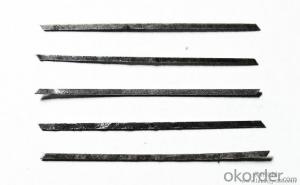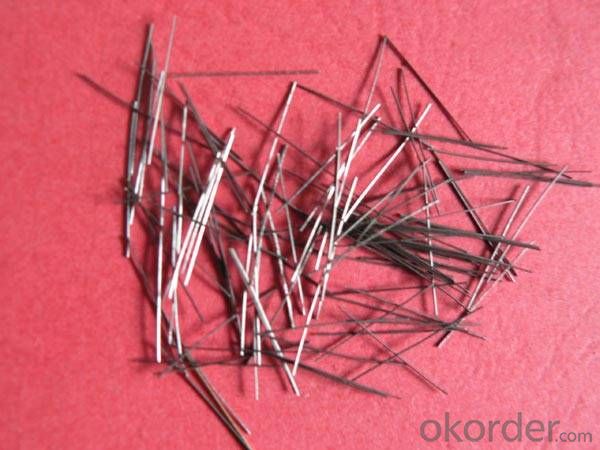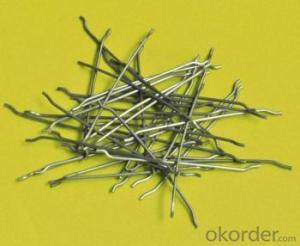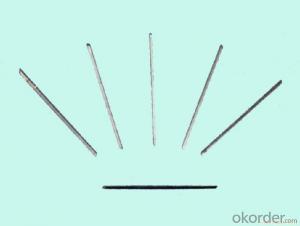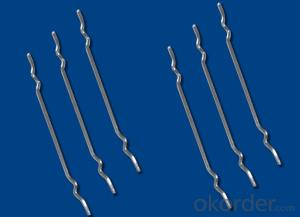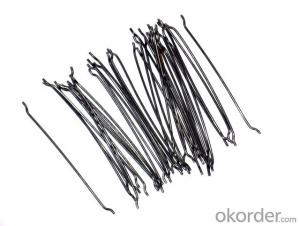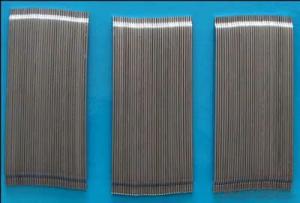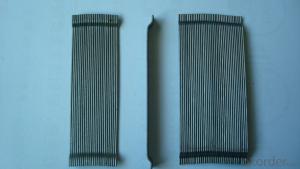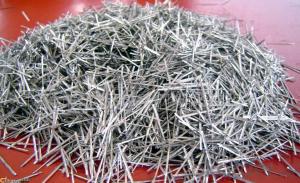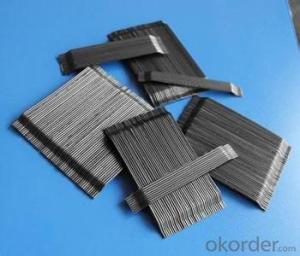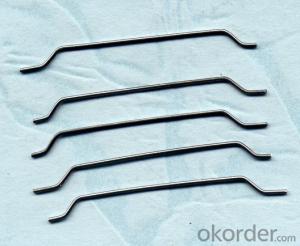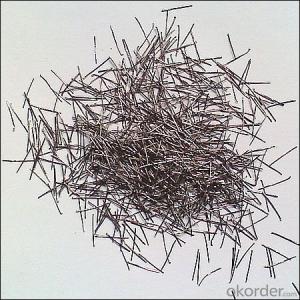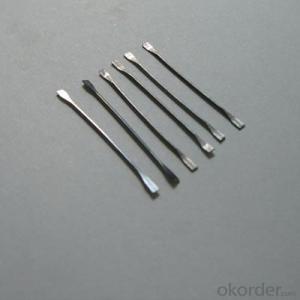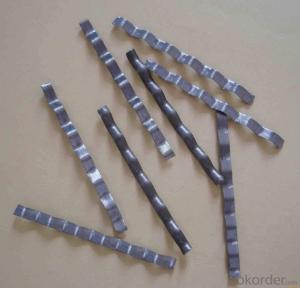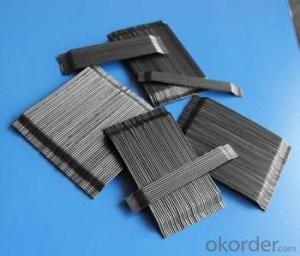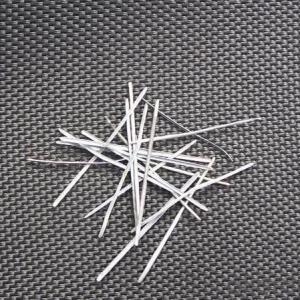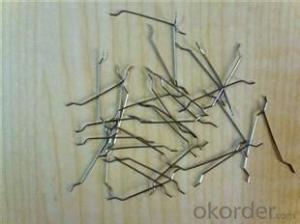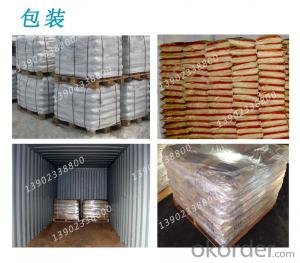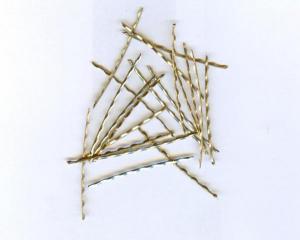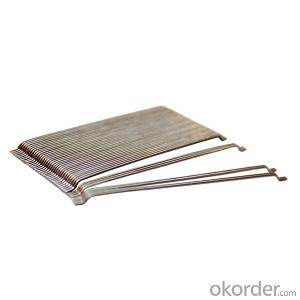Melt Extract Stainless Steel Fiber Reinforced High Tensile Strength Steel Fiber Construction New Material for Highway and Airport Pavement
- Loading Port:
- Tianjin
- Payment Terms:
- TT OR LC
- Min Order Qty:
- 5 kg
- Supply Capability:
- 30000 kg/month
OKorder Service Pledge
OKorder Financial Service
You Might Also Like
Quick Details
Place of Origin: Jiangsu, China (Mainland)
Model Number: HT-ST
Material: Steel
Specifications
Material: round cold drawn wire
Wire diameter: 1.0mm+-0.05mm
Fiber length: 35MM
Fiber diameter: 0.75mm
Tensile strength: ≥1100Mpa
Elongation at break: < 4%
Appearance:bright and clean wire
Package and storage
20KG damp-proof poly and paper composite bag. 50 bags/pallet.
The pallets should be protected against rain and snow.
Other specification:
Item | Diameter (mm) | Length (mm) | Aspect Radio (L/D) | Tensile Strength (MPa) |
G50/ 25BN | 0.5 | 25 | 50 | ≥1100 |
G60/ 30BN | 0.5 | 30 | 60 | ≥1100 |
G70/ 35BN | 0.5 | 35 | 70 | ≥1100 |
G70/ 35BN | 0.6 | 25 | 42 | ≥1100 |
G50/ 30BN | 0.6 | 30 | 50 | ≥1100 |
G58/ 35BN | 0.6 | 35 | 58 | ≥1100 |
G40/ 30BN | 0.75 | 30 | 40 | ≥1100 |
G47/ 35BN | 0.75 | 35 | 47 | ≥1100 |
G80/ 60BN | 0.75 | 60 | 80 | ≥1100 |
G38/ 30BN | 0.8 | 30 | 38 | ≥1100 |
G44/ 35BN | 0.8 | 35 | 44 | ≥1100 |
G75/ 60BN | 0.8 | 60 | 75 | ≥1100 |
G56/ 50BN | 0.9 | 50 | 56 | ≥1100 |
G67/ 60BN | 0.9 | 60 | 67 | ≥1100 |
G50/ 50BN | 1.0 | 50 | 50 | ≥1100 |
G60/ 60BN | 1.0 | 60 | 60 | ≥1100 |
Picture
Steel fiber straight type
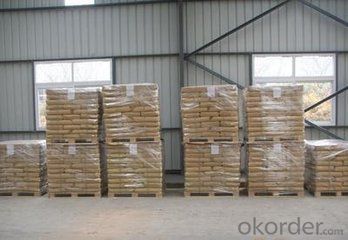
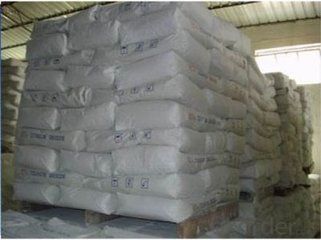
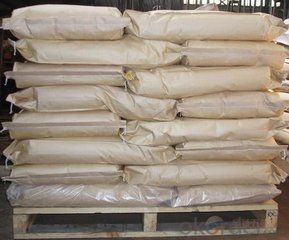
FAQ
certificated: ISO 9001
Technical advantages of Daye steel fiber:
A. Improve mechanical performance of concrete
B. Provide uniform distribution throughout concrete with excellent mixing
C. No balling or caking by adopt correct mixing method
D. Reduce concrete volume
E.Save construction time and cost
F.Reduce excavation volume
G.Available for jointless floor.
- Q: Can melt extract stainless steel fiber be used in refractory concrete applications?
- Yes, melt extract stainless steel fiber can indeed be used in refractory concrete applications. Refractory concrete is a type of concrete that is designed to withstand high temperatures and retain its strength and structural integrity under extreme heat conditions. The addition of stainless steel fibers to refractory concrete can significantly enhance its thermal shock resistance, crack resistance, and overall mechanical properties. Melt extract stainless steel fibers are manufactured through a process called melt extraction, where molten stainless steel is rapidly cooled and solidified to form thin, elongated fibers. These fibers possess excellent thermal conductivity, high tensile strength, and good corrosion resistance, making them ideal for use in refractory concrete. The addition of stainless steel fibers to refractory concrete can improve its ability to resist thermal cracking and spalling caused by rapid temperature changes. The fibers act as reinforcement, distributing the stress across the concrete matrix and preventing the formation of cracks. This enhances the durability and longevity of refractory concrete in high-temperature environments. Furthermore, stainless steel fibers can also improve the mechanical properties of refractory concrete. They increase the tensile strength and flexural strength of the concrete, making it more resistant to mechanical stress and ensuring its structural integrity even at elevated temperatures. In summary, melt extract stainless steel fiber is a suitable material for use in refractory concrete applications. Its addition can enhance the thermal shock resistance, crack resistance, and mechanical properties of refractory concrete, making it more durable and reliable in high-temperature environments.
- Q: Can melt extract stainless steel fiber be used in roller-compacted concrete (RCC)?
- Yes, melt extract stainless steel fiber can be used in roller-compacted concrete (RCC).
- Q: What is the effect of melt extract stainless steel fiber on the crack width in concrete?
- The crack width in concrete is significantly affected by the utilization of melt extract stainless steel fibers. These fibers are incorporated into the concrete mixture to enhance its durability and strength. In the event of external forces or temperature fluctuations, cracks may develop. However, the presence of stainless steel fibers aids in controlling and minimizing the width of these cracks. The primary reason behind this impact lies in the distinctive properties of stainless steel fibers. These fibers are recognized for their high tensile strength and ductility. When cracks begin to form in the concrete, the stainless steel fibers serve as reinforcement and distribute the stress throughout the matrix. This redistribution of stress helps prevent the cracks from expanding. Furthermore, the inclusion of stainless steel fibers also enhances the overall toughness of the concrete. Consequently, the concrete becomes more resistant to the propagation of cracks. This implies that even if cracks do occur, they are less likely to propagate and cause significant damage. Furthermore, melt extract stainless steel fibers also enhance the overall durability of the concrete. They function as a protective barrier against corrosion, safeguarding the concrete from the detrimental effects of moisture, chemicals, and other environmental factors. This increases the lifespan of the concrete structure and reduces the frequency of repairs or replacements. To summarize, the utilization of melt extract stainless steel fibers in concrete has a favorable impact on crack width. These fibers reinforce the concrete matrix, distribute stress, and prevent cracks from expanding. Additionally, they enhance the overall toughness and durability of the concrete, making it more resilient to crack propagation and extending its lifespan.
- Q: Can melt extract stainless steel fiber be used in architectural concrete finishes?
- Yes, melt extract stainless steel fiber can be used in architectural concrete finishes. It is commonly used to improve the durability, strength, and crack resistance of concrete, making it suitable for various architectural applications.
- Q: Is melt extract stainless steel fiber corrosion-resistant?
- Yes, melt extract stainless steel fiber is corrosion-resistant.
- Q: How does melt extract stainless steel fiber improve the shear strength of concrete?
- Melt extract stainless steel fiber improves the shear strength of concrete by acting as reinforcement within the material. When added to concrete, these fibers are distributed randomly throughout the mixture, creating a three-dimensional network that enhances the overall structural integrity. The unique properties of stainless steel, such as its high tensile strength and corrosion resistance, make it an ideal material for improving the shear strength of concrete. As the concrete undergoes shear forces, the steel fibers act as tiny reinforcing bars, effectively transferring the stress between the different sections of concrete and reducing the likelihood of cracks or failure. Due to their small size and high aspect ratio, melt extract stainless steel fibers are able to bridge the micro-cracks that may develop within the concrete. This bridging effect helps to distribute the shear forces more evenly across the material, preventing the formation of large cracks and enhancing the overall shear resistance. Furthermore, the presence of stainless steel fibers in the concrete matrix also increases the frictional resistance between the fibers and the surrounding material, further improving the shear strength. This frictional interaction between the fibers and the concrete helps to resist the sliding and separation of the concrete layers, ultimately enhancing the shear performance. In summary, melt extract stainless steel fiber improves the shear strength of concrete through its reinforcing action, bridging effect, and increased frictional resistance. By incorporating these fibers into the concrete mix, engineers can enhance the overall structural performance and durability of concrete structures, making them more resistant to shear forces and potential failure.
- Q: Can melt extract stainless steel fiber be used in bridge abutments?
- Yes, melt extract stainless steel fiber can be used in bridge abutments. Stainless steel fibers have high tensile strength and excellent corrosion resistance, making them suitable for reinforcing concrete structures. In bridge abutments, which are critical components for supporting the bridge deck and transferring loads to the foundation, the use of stainless steel fibers can enhance the durability and overall performance of the structure. These fibers can effectively improve the crack resistance and flexural strength of the concrete, reducing the potential for cracking and improving the load-bearing capacity of the abutments. Additionally, the corrosion resistance of stainless steel fibers ensures long-term durability in harsh environmental conditions, such as exposure to moisture and deicing salts. Therefore, incorporating melt extract stainless steel fiber in bridge abutments can provide numerous benefits, including increased structural integrity, reduced maintenance needs, and extended service life.
- Q: What is the effect of melt extract stainless steel fiber on the freeze-thaw resistance of concrete?
- The addition of melt extract stainless steel fiber to concrete has a significant positive effect on its freeze-thaw resistance. Stainless steel fibers are highly resistant to corrosion and have excellent mechanical properties, making them ideal for enhancing the durability of concrete in harsh environmental conditions. During freeze-thaw cycles, water in the concrete pores expands when it freezes, exerting pressure on the surrounding material. This pressure can cause cracking and deterioration of the concrete, leading to reduced strength and increased permeability. However, the inclusion of melt extract stainless steel fibers helps to mitigate these effects. The fibers act as reinforcement within the concrete matrix, effectively bridging microcracks that may occur during freeze-thaw cycles. This bridging effect helps to distribute stress and prevent the propagation of cracks, thereby improving the overall durability of the concrete. Furthermore, stainless steel fibers have a low thermal conductivity, which reduces the transfer of heat from the surrounding environment to the concrete. This slower temperature change minimizes the formation of ice crystals within the concrete during freezing, further reducing the potential for damage. Overall, the addition of melt extract stainless steel fiber to concrete enhances its resistance to freeze-thaw cycles, increasing its durability and lifespan. This improvement in freeze-thaw resistance is crucial in regions with cold climates or areas where concrete structures are exposed to frequent temperature fluctuations.
- Q: Is melt extract stainless steel fiber resistant to corrosion?
- Melt extract stainless steel fiber exhibits exceptional resistance to corrosion. It is produced from a top-quality steel alloy that incorporates chromium, forming a protective layer on the fiber's surface. This layer, called a passive layer, effectively shields the steel from direct contact with corrosive elements found in the surroundings, such as moisture, oxygen, and chlorides. Consequently, the fiber maintains its resistance to rust and corrosion even in extreme conditions, including high temperatures, acidic or alkaline environments, and exposure to chemicals. Hence, melt extract stainless steel fiber proves to be an outstanding option for various applications requiring corrosion resistance, such as concrete reinforcement, refractory materials, and composite materials.
- Q: Can melt extract stainless steel fiber be used in the construction of railway tracks?
- Yes, melt extract stainless steel fiber can be used in the construction of railway tracks. It is commonly used as a reinforcement material in concrete to enhance its strength, durability, and resistance to cracking. In railway track construction, using stainless steel fiber can help improve the overall stability and lifespan of the tracks, ensuring safe and reliable transportation.
Send your message to us
Melt Extract Stainless Steel Fiber Reinforced High Tensile Strength Steel Fiber Construction New Material for Highway and Airport Pavement
- Loading Port:
- Tianjin
- Payment Terms:
- TT OR LC
- Min Order Qty:
- 5 kg
- Supply Capability:
- 30000 kg/month
OKorder Service Pledge
OKorder Financial Service
Similar products
Hot products
Hot Searches
Related keywords
